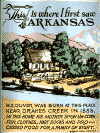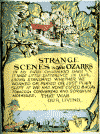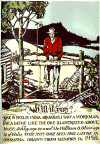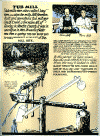M.E. Oliver's Strange Scenes in the Ozarks




The Rogers Historical Museum published this description on its website in July 2003, when the museum's copy of Strange Scenes in the Ozarks was selected the museum's gift of the month. The description is presented here with the kind permission of the museum.
Marvin Elmer Oliver (1888-1974) was born in a log cabin on Drakes Creek, a few miles southeast of Huntsville, Arkansas. His mother died when Elmer was a boy, so to lessen the strain on the family of eight he made a five-day, 160-mile journey, mostly on foot, to Viola, Arkansas, to live with relatives. As a young man he worked as a farmhand; later he moved to Oklahoma to work in a broom factory. Becoming interested in art, he signed up for a correspondence course only to have World War I interrupt his plans.
But art was never far from his thoughts. While serving in France as a company dispatcher and bugler with the 308th Battalion, 7th Infantry, he spent his spare time sketching. Even when was wounded and sent to recuperate in a Little Rock hospital, he continued to sketch everything in sight. After his discharge he studied art as part of a vocational and rehabilitation program for veterans, eventually enrolling in the School of Fine and Applied Arts in New York City. Illustrator Charles Dana Gibson, famous for his "Gibson Girl" portraits, was one of his tutors.
After graduation Oliver worked as a free-lance commercial artist, illustrating book jackets and magazine covers for publisher Harper & Brothers and the Magazine of Wall Street. He also worked for a short time with a Dallas advertising agency before returning to his beloved Ozarks.
In 1927 he married Bessie Simmons of Combs, Arkansas, and for many years the two ran a successful 140-acre fruit farm near Japton, southeast of Huntsville. But the remote location of the farm and the amount of money spent maintaining the dirt roads meant that the couple rarely made a profit. They moved to Huntsville in 1940 where Oliver went to work for the Selective Service. He later served as a state revenue inspector and as a municipal judge.
Oliver retired in 1954 and once again turned his attention to art. Wanting to preserve the old pioneering way of life that was fast disappearing, in 1955 he self-published Strange Scenes in the Ozarks. Part oral history and part "Ripley's Believe It or Not," Strange Scenes used wonderful images and quaint lettering to convey an Arkansas that was. With its depictions of panthers, bears, saw mills, log cabins, shooting matches, and country folk, Strange Scenes is like an early Ozark version of the "Foxfire" series of books which examined the old-time traditions of southern Appalachia.
Getting the details right was important. Oliver relied on his memory and that of his elderly country neighbors to sketch out a puncheon house (a log cabin made from halved tree trunks), a mountain rascal (a one-poster bed built into a cabin's corner walls), and a tub mill (a perpetual-motion-like device which used water to continually mill grain). He even built a small model of the latter to make sure it would work; based on Oliver's design, the folks at Silver Dollar City built a larger version for their pioneer-themed amusement park in Branson, Missouri.
Strange Scenes has whimsical elements as well. A stork carrying a baby in a sling flies through the title "This is where I first saw Arkansas," above the image of the cabin where Oliver was born. An angler braces himself against the strong pull of the fish he has managed to land in the pond near "Hawkins Mill." A clown scampers ahead of a circus elephant in "Jumbo and Drakes Creek." And a man covers his eyes as a bucking steer plunges its rider into a stream on the book's final page, "Tale Ends."
While the book's content is a great resource of early Ozark folkways for historians, it's the fabulous graphics which enchant the viewer. The simple, blocky style of the drawings, lettering, and borders is reminiscent of the work found in art-instruction books of the 1920s, which makes sense when one considers that that was the decade which saw Oliver attend art school and embark on his budding art career. But the artistic style of the illustrations was also influenced by the needs of the printmaker. To produce "Strange Scenes", Oliver relied on a printmaking technique that he had used during his commercial art days—silk-screen printing or serigraphy (seri from the Latin "silk," graphos from the Greek "to write").
After Oliver completed a painting or a detailed sketch of his subject he created a simpler line drawing of the image using India ink. He also made a drawing to indicate blocks of color—pale blue for the sky, mauve for the mountains, olive green for the trees, and so on. To print each color a separate stencil was first cut from a material Oliver called "sensitized plastic" (possibly an adhesive-backed film). Once the stencil was adhered to a silk-lined wood frame, a thin layer of printer's ink was forced through the unblocked areas of the fabric and onto a sheet of paper. After one color dried the next was added, until the final picture emerged. Oliver used two to eight, sometimes vibrant, sometimes muted, handmade inks to print each of the book's 30 illustrations.
An exacting, labor-intensive process such as this meant that Oliver could only produce a limited run of Strange Scenes in the Ozarks—400 copies in all. Although the book in the Museum's collection is dated 1955, it appears that Oliver added a few illustrations to it in later years; some of the pages are dated 1958 and 1963. Later Oliver embarked on a project to draw the area's historic water mills. Old Mills of the Ozarks, published in 1969, featured sketches, descriptions, and locations of 20 mills.